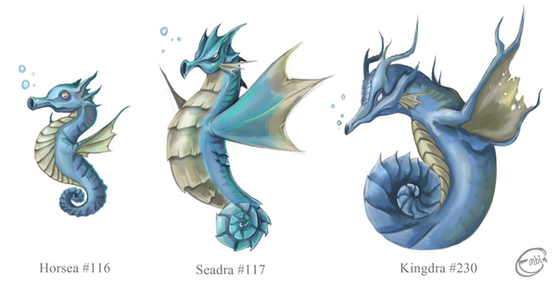HOME | DD
 CosmicJackalope — Feraligatr Variations
CosmicJackalope — Feraligatr Variations

#feraligatr #pokemon #water #variations
Published: 2015-03-25 08:13:50 +0000 UTC; Views: 7711; Favourites: 157; Downloads: 0
Redirect to original
Description
I was inspired by each of these by the iguana on the Galapagos islands, and the megalodon and great white shark. If people like these, I might draw some more detailed sketches if theres an interest. They were fun to make. Hope everyone likes them.------
My contribution to the pokemon variations. I choose Feraligatr, my favorite pokemon.
Common/Ocean: The most well known Feraligatr, largest of the currently living variations, and able to live in almost all environments. Found primarily in the open ocean and recognized by it's blue and yellow coloring, most commonly with red spines, but the rare recessive variety having blue spines. Preferred for battling due to it's enormous size, strength, and powerful jaws. It's personality is tamer than the other varieties which are either to aggressive, or to skittish.
River/Bay: Found often in more hidden enclaves such as bays, or rivers. These feraligatr are recognized by their hooked snout, and distinctive red spots. Often found lying on a sandy bank with it's mouth open and sleeping. The red spots collect sunlight to give it energy, and make for impressive display during breeding season. They however are slower moving than the other species and are primarily ambush predators, feeding once a year during the Tauros migration.
Inner Island: The first of a specialty species located only on one island off of near Johto, and critically endangered. This variety are smaller than the other species, a perfect example of Insular Dwarfism, a topic of study by many pokemon researchers. The inner island variety is hard to place given it's lack of water type moves, and it's preference for jungle environment. The males and females both have large teeth which continue to grow through it's life and used for intimidation.
Marine Island: The second from the same island as the Inner Island variety, but slightly larger. These feraligatr are also critically endangered, and live most of their lives along the coast and rarely venture into the inner island, however cross breeding between the two has occurred. The marine variety are streamlined and long limbed. Marine feraligatr have bio-luminescent spots on their snout, and under the eye, as well as poisonous spines they use for communication under water, and for protection. They were for a long time classified as a poison/water type, but further research has shown that they do not actually create their own luminescence or poison, but rather use the poison and luminescence from the tentacool they prey on.
Prehistoric: The ancient cousin to the modern feraligatr, these beasts were enormous in size and well one of the top predators of their time, however their brains were smaller than the current species. They died off in a mass extinction around the same time as the omanyte. Attempts to resurrect this pokemon has been made, but currently unsuccessful.
Related content
Comments: 6

👍: 0 ⏩: 0

Prehistoric is my favorite!
inner island is my second favorite -w-
👍: 0 ⏩: 0

I love how you did these! The prehistoric is my favorite Cx
And they're so well drawn, they look very realistic!
👍: 0 ⏩: 1

Thank you! I'm thinking of doing some full body versions, they were fun to draw.
👍: 0 ⏩: 1


























